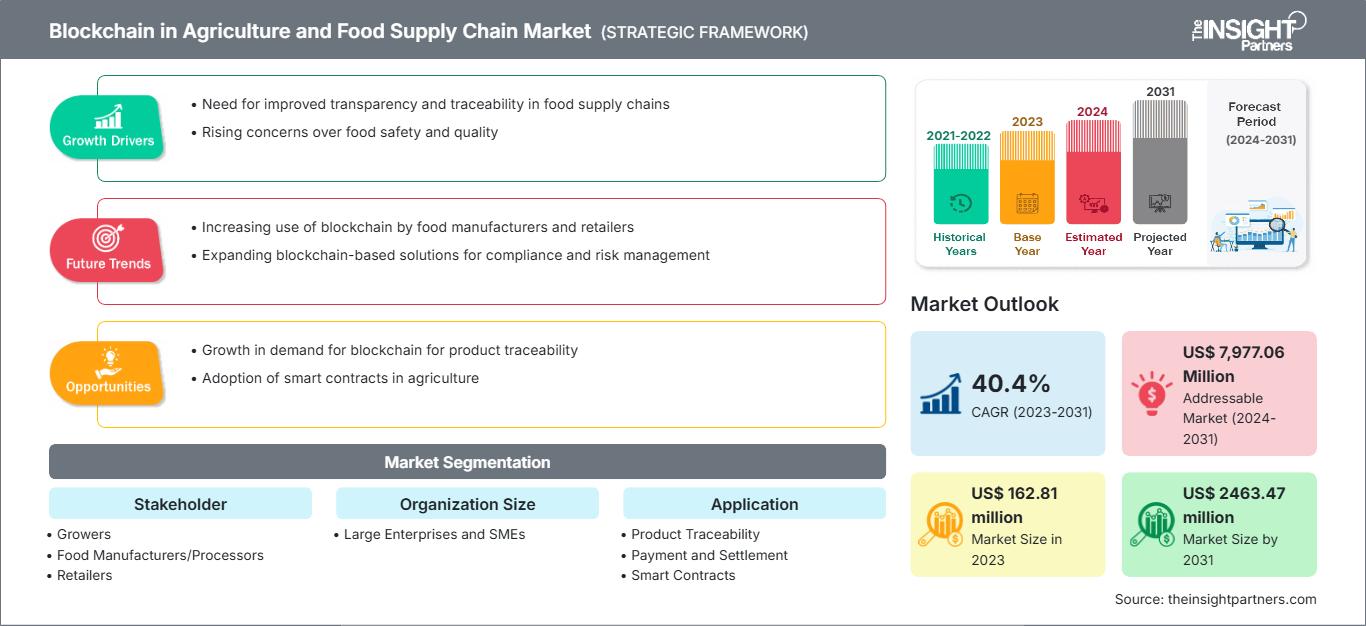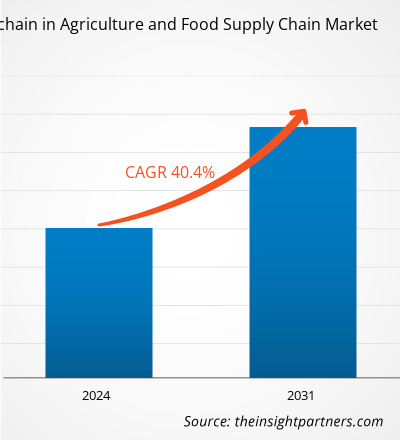Der Markt für Blockchain in der Landwirtschaft und Lebensmittelversorgungskette soll von 162,81 Millionen US-Dollar im Jahr 2023 auf 2463,47 Millionen US-Dollar im Jahr 2031 wachsen; von 2023 bis 2031 wird mit einer durchschnittlichen jährlichen Wachstumsrate von 40,4 % gerechnet. Verbesserte Rückverfolgbarkeit und Transparenz, die Nachfrage der Verbraucher nach Transparenz, Effizienz der Lieferkette, die Verhinderung von Lebensmittelbetrug und -kontamination sowie die Reduzierung von Lebensmittelabfällen treiben das Wachstum der Blockchain in der Landwirtschaft und Lebensmittelversorgungskette voran.
Marktanalyse für Blockchain in der Landwirtschaft und Lebensmittelversorgungskette
Die wachsende Nachfrage nach Blockchain-Technologie von kleinen und mittleren Unternehmen hat die Präsenz der Blockchain in der Landwirtschaft und Lebensmittelversorgungskette gestärkt. Darüber hinaus wird erwartet, dass die Integration von Geräten des Internets der Dinge (IoT) die Expansion der Märkte im Prognosezeitraum beschleunigen wird. Darüber hinaus ergreifen große Unternehmen verschiedene Initiativen, um ihr Portfolio und ihre globale Präsenz zu erweitern, was sich zu einem wichtigen Blockchain-Trend im Agrar- und Lebensmittelversorgungskettenmarkt entwickelt hat.
Marktübersicht zu Blockchain im Agrar- und Lebensmittelversorgungskettenmarkt
- Landwirtschaftliche Unternehmen interessieren sich zunehmend für die Blockchain-Technologie. Unternehmen heben sich schrittweise ab, indem sie demonstrieren, wie Lieferkettenwissen geschaffen und Transaktionsengpässe durch verbesserte Datenmanagementkompetenzen infolge der Technologieentwicklung reduziert werden.
- Der Agrarsektor unterstreicht, wie wertvoll Technologie für die Senkung von Transaktionskosten, die Rationalisierung der Logistik, die Verbesserung der Rückverfolgbarkeit und die Verbesserung von Lebensmittelsicherheitsverfahren ist.
- Blockchain-Technologie bietet eine spannende Möglichkeit, die Transparenz zu verbessern, Widerstände abzubauen und die transaktionsbezogene Effizienz in globalen Agrarversorgungsketten zu steigern.
Passen Sie diesen Bericht Ihren Anforderungen an
Sie erhalten kostenlos Anpassungen an jedem Bericht, einschließlich Teilen dieses Berichts oder einer Analyse auf Länderebene, eines Excel-Datenpakets sowie tolle Angebote und Rabatte für Start-ups und Universitäten.
Blockchain im Agrar- und Lebensmittelversorgungsmarkt: Strategische Einblicke

- Holen Sie sich die wichtigsten Markttrends aus diesem Bericht.Dieses KOSTENLOSE Beispiel umfasst Datenanalysen, die von Markttrends bis hin zu Schätzungen und Prognosen reichen.
Sie erhalten kostenlos Anpassungen an jedem Bericht, einschließlich Teilen dieses Berichts oder einer Analyse auf Länderebene, eines Excel-Datenpakets sowie tolle Angebote und Rabatte für Start-ups und Universitäten.
Blockchain im Agrar- und Lebensmittelversorgungsmarkt: Strategische Einblicke

- Holen Sie sich die wichtigsten Markttrends aus diesem Bericht.Dieses KOSTENLOSE Beispiel umfasst Datenanalysen, die von Markttrends bis hin zu Schätzungen und Prognosen reichen.
Marktchancen für Blockchain in der Landwirtschaft und Lebensmittelversorgungskette
Integration von Geräten des Internets der Dinge (IoT) schafft Chancen für das Marktwachstum von Blockchain in der Landwirtschaft und Lebensmittelversorgungskette
- Die Integration von Geräten des Internets der Dinge (IoT) mit Blockchain-Technologie für Landwirtschaft und Lebensmittelversorgungsketten verbessert die Datenerfassung und Echtzeitüberwachung, was zu mehr Transparenz, Rückverfolgbarkeit und Qualitätskontrolle sowie zu einer gesteigerten Effizienz der Lieferkette führt.
- Unternehmen sichern Daten in Geräten des Internets der Dinge mit Blockchain. Intelligente Geräte können Daten austauschen und andere Finanzaktivitäten auf skalierbare, sichere und zuverlässige Weise durchführen, wenn Blockchain-Technologie in Verbindung mit IoT-Geräten verwendet wird.
- Darüber hinaus ermöglicht Blockchain-Technologie in Kombination mit IoT Organisationen den Austausch und Zugriff auf Daten ohne die Notwendigkeit einer zentralen Kontrolle und Verwaltung, was das Wachstum des Blockchain-Marktes in der Landwirtschaft und Lebensmittelversorgungskette weiter vorantreibt.
Segmentierungsanalyse des Marktberichts zu Blockchain in der Landwirtschaft und Lebensmittelversorgungskette
- Basierend auf der Unternehmensgröße ist der Blockchain-Markt in der Landwirtschaft und Lebensmittelversorgungskette in Großunternehmen und KMU segmentiert. Das Segment der Großunternehmen wird voraussichtlich im Jahr 2023 einen beträchtlichen Marktanteil im Bereich Blockchain in der Landwirtschaft und Lebensmittelversorgungskette halten.
- Größere Unternehmen investieren kontinuierlich in fortschrittliche Technologien wie Blockchain, um ihre Landwirtschaft und Lebensmittelversorgungskette zu verbessern, was das Wachstum dieses Segments auf dem Markt fördert.
- Auch KMU arbeiten an der Einführung der Blockchain-Technologie, da diese ihnen hilft, ihr Getreide entlang der Wertschöpfungskette zu verfolgen und zu verwalten, was das Marktwachstum im Prognosezeitraum weiter vorantreibt.
Analyse des Marktanteils von Blockchain in der Landwirtschaft und Lebensmittelversorgungskette nach geografischen Gesichtspunkten
Der Markt für Blockchain in der Landwirtschaft und Lebensmittelversorgungskette ist hauptsächlich in fünf Regionen unterteilt: Nordamerika, Europa, Asien-Pazifik, Naher Osten und Afrika sowie Südamerika. Nordamerika erlebt ein schnelles Wachstum und wird voraussichtlich einen bedeutenden Marktanteil im Bereich Blockchain in der Landwirtschaft und Lebensmittelversorgungskette halten. Nordamerika hat moderne Technologien für die Landwirtschaft und die Lebensmittelversorgungskette deutlich schneller eingeführt als andere Regionen und verfügt daher über den größten Marktanteil. Darüber hinaus sind die USA und Kanada die wirtschaftlich stabilsten Länder der Region und machen einen beträchtlichen Marktanteil aus.
Blockchain in der Landwirtschaft und LebensmittelversorgungsketteRegionale Einblicke in den Markt für Blockchain in der Landwirtschaft und Lebensmittelversorgungskette
Regionale Einblicke in den Markt für Blockchain in der Landwirtschaft und Lebensmittelversorgungskette
Die Analysten von The Insight Partners haben die regionalen Trends und Faktoren, die den Blockchain-Markt in der Landwirtschaft und Lebensmittelversorgungskette im Prognosezeitraum beeinflussen, ausführlich erläutert. In diesem Abschnitt werden auch die Marktsegmente und die geografische Lage von Blockchain in der Landwirtschaft und Lebensmittelversorgungskette in Nordamerika, Europa, im asiatisch-pazifischen Raum, im Nahen Osten und Afrika sowie in Süd- und Mittelamerika erörtert.
Umfang des Marktberichts über Blockchain in der Landwirtschaft und Lebensmittelversorgungskette
| Berichtsattribut | Einzelheiten |
|---|---|
| Marktgröße in 2023 | US$ 162.81 million |
| Marktgröße nach 2031 | US$ 2463.47 million |
| Globale CAGR (2023 - 2031) | 40.4% |
| Historische Daten | 2021-2022 |
| Prognosezeitraum | 2024-2031 |
| Abgedeckte Segmente |
By Interessengruppen
|
| Abgedeckte Regionen und Länder | Nordamerika
|
| Marktführer und wichtige Unternehmensprofile |
|
Blockchain in der Landwirtschaft und der Lebensmittelversorgungskette: Die Auswirkungen auf die Geschäftsdynamik verstehen
Der Markt für Blockchain in der Landwirtschaft und Lebensmittelversorgung wächst rasant. Dies wird durch die steigende Endverbrauchernachfrage aufgrund von Faktoren wie sich entwickelnden Verbraucherpräferenzen, technologischem Fortschritt und einem stärkeren Bewusstsein für die Produktvorteile vorangetrieben. Mit steigender Nachfrage erweitern Unternehmen ihr Angebot, entwickeln Innovationen, um den Bedürfnissen der Verbraucher gerecht zu werden, und nutzen neue Trends, was das Marktwachstum weiter ankurbelt.

- Holen Sie sich die Blockchain im Agrar- und Lebensmittelversorgungsmarkt Übersicht der wichtigsten Akteure
Die „Marktanalyse für Blockchain in der Landwirtschaft und Lebensmittelversorgungskette“ wurde auf Grundlage von Interessengruppen, Unternehmensgröße, Anwendung und Geografie durchgeführt. Auf Grundlage der Interessengruppen ist der Markt in Erzeuger, Lebensmittelhersteller/-verarbeiter und Einzelhändler segmentiert. Auf Grundlage der Unternehmensgröße ist der Markt in Großunternehmen und KMU segmentiert. Auf Grundlage der Anwendung ist der Blockchain-Markt in der Landwirtschaft und Lebensmittelversorgungskette in Produktrückverfolgbarkeit, Zahlung und Abwicklung, Smart Contracts sowie Governance-Risiko- und Compliance-Management segmentiert. Auf Grundlage der Geografie ist der Markt in Nordamerika, Europa, Asien-Pazifik, den Nahen Osten und Afrika sowie Südamerika segmentiert.
Marktnachrichten und aktuelle Entwicklungen zu Blockchain in der Landwirtschaft und Lebensmittelversorgungskette
Unternehmen verfolgen im Markt für Landwirtschaft und Lebensmittelversorgungskette anorganische und organische Strategien wie Fusionen und Übernahmen in der Blockchain. Einige wichtige Marktentwicklungen der letzten Zeit sind nachfolgend aufgeführt:
- Im März 2021 kündigte BlockApps, ein Anbieter von Blockchain-Plattformen für Unternehmen, die Erweiterung des TraceHarvest-Netzwerks mit Amazon Web Services (AWS) an. Die Blockchain-Lösung TraceHarvest von BlockApps wird AWS nutzen, um den Agrarkunden von TraceHarvest schnellen und flexiblen Zugriff auf die Cloud zu bieten. TraceHarvest ermöglicht es Kunden, den gesamten Lebenszyklus landwirtschaftlicher Produkte ab der Saatgutquelle mithilfe der Blockchain zu verfolgen und zurückzuverfolgen.
[Quelle: BlockApps, Unternehmenswebsite]
- Im Januar 2020 kündigten Farmer Connect und IBM eine neue mobile Verbraucheranwendung namens „Thank My Farmer“ an, mit der Kaffeetrinker ihren Kaffee zurückverfolgen können, um dessen Qualität und Herkunft zu verstehen und sogar den Bauern zu unterstützen, der die Bohnen angebaut hat. Farmer Connect ist eine Rückverfolgbarkeitsplattform auf Basis von IBM Blockchain, die dazu beitragen soll, die Rückverfolgbarkeit, Effizienz und Fairness in der Kaffee-Lieferkette zu verbessern.
[Quelle: IBM, Unternehmenswebsite]
Abdeckung und Ergebnisse des Marktberichts zu Blockchain in der Landwirtschaft und Lebensmittelversorgungskette
Die Marktprognose für Blockchain in der Landwirtschaft und Lebensmittelversorgungskette wird auf Grundlage verschiedener sekundärer und primärer Forschungsergebnisse geschätzt, wie z. B. wichtiger Unternehmensveröffentlichungen, Verbandsdaten und Datenbanken. Der Marktbericht „Marktgröße und Prognose für Blockchain in der Landwirtschaft und Lebensmittelversorgungskette (2021–2031)“ bietet eine detaillierte Analyse des Marktes und deckt die folgenden Bereiche ab:
- Marktgröße und -prognose auf globaler, regionaler und Länderebene für alle abgedeckten wichtigen Marktsegmente.
- Marktdynamik wie Treiber, Beschränkungen und wichtige Chancen.
- Wichtige zukünftige Trends.
- Detaillierte PEST- und SWOT-Analyse
- Globale und regionale Marktanalyse mit wichtigen Markttrends, Hauptakteuren, Vorschriften und aktuellen Marktentwicklungen.
- Branchenlandschafts- und Wettbewerbsanalyse mit Marktkonzentration, Heatmap-Analyse, Hauptakteuren und aktuellen Entwicklungen.
- Detaillierte Unternehmensprofile.
- Historische Analyse (2 Jahre), Basisjahr, Prognose (7 Jahre) mit CAGR
- PEST- und SWOT-Analyse
- Marktgröße Wert/Volumen – Global, Regional, Land
- Branchen- und Wettbewerbslandschaft
- Excel-Datensatz
Aktuelle Berichte
Verwandte Berichte
Erfahrungsberichte
Grund zum Kauf
- Fundierte Entscheidungsfindung
- Marktdynamik verstehen
- Wettbewerbsanalyse
- Kundeneinblicke
- Marktprognosen
- Risikominimierung
- Strategische Planung
- Investitionsbegründung
- Identifizierung neuer Märkte
- Verbesserung von Marketingstrategien
- Steigerung der Betriebseffizienz
- Anpassung an regulatorische Trends




















 Kostenlose Probe anfordern für - Blockchain im Agrar- und Lebensmittelversorgungsmarkt
Kostenlose Probe anfordern für - Blockchain im Agrar- und Lebensmittelversorgungsmarkt